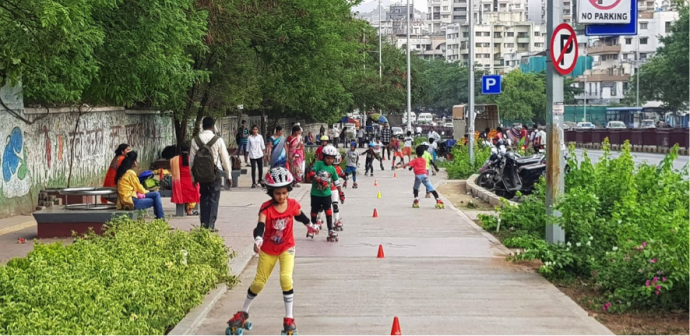prioritise better street design over traffic fines for road safety in india

There is this whole narrative of demand for strict traffic rules and imposing stringent fine as a magic wand to control road accidents and fatalities while ignoring pathetic road infra & street design in cities in India. But before enforcing strict traffic rules and imposing monetary fines, focusing on street design can yield several benefits. But before enforcing strict traffic rules and imposing monetary fines, focusing on street design can yield several benefits.
Here is how cities from Europe to Latin America to Indian cities are doing to make streets safer for all.
Focus on Prevention over Punishment
Effective street design can inherently encourage safe and responsible behaviour among road users. When streets are designed with clear signage, crosswalks, designated lanes for different modes of transportation, and well-defined intersections, people are more likely to follow the intended rules naturally. This reduces the need for aggressive enforcement and heavy fines, as compliance becomes a norm rather than an exception.

Example: In cities like Copenhagen, Denmark, and Amsterdam, Netherlands, comprehensive street designs prioritise pedestrians and cyclists, making it safer and more convenient for them to navigate. As a result, people follow the rules naturally, leading to lower accident rates and a culture of responsible road use.
Roads Need Human-Centered Approach
People are more likely to follow rules and regulations when they feel that their needs and safety are considered. Well-designed streets that prioritise pedestrians, cyclists, and public transport users can enhance the overall urban experience, making people more willing to comply with traffic rules.

Example: Bogotá, Colombia, introduced the concept of “Ciclovía” where major streets are closed to vehicles on Sundays and holidays, allowing people to walk, bike, and socialize freely. This initiative was so well-received that it not only encouraged adherence to traffic rules but also promoted a healthier and more active lifestyle.
Reduced Conflict Points through Complete Street Design
Effective street design minimizes potential conflicts between different modes of transportation. Separating lanes for cars, bicycles, and pedestrians reduces the likelihood of accidents and misunderstandings among road users. This can help decrease the need for strict enforcement and fines arising from avoidable conflicts.

Example: In Seoul, South Korea, the Cheonggyecheon Stream Restoration Project involved converting a major roadway into an urban park and pedestrian-friendly space. This redesign not only improved safety but also led to a more harmonious coexistence of various modes of transport, naturally reducing the need for strict enforcement.
Encouraging & Incencitvize Sustainable Transportation
Well-designed streets can promote the use of sustainable modes of transportation, such as walking, cycling, and public transit. This can lead to fewer vehicles on the road, reducing congestion, pollution, and the potential for accidents. When people have viable alternatives to driving, the incentive to adhere to traffic rules and avoid fines increases.

Example: Curitiba, Brazil, implemented a highly successful Bus Rapid Transit (BRT) system that efficiently moves people around the city. This initiative led to reduced traffic congestion, improved air quality, and a shift towards more responsible and sustainable transportation choices.
Galvanise Public Support and Participation
Involving the community in street design and planning fosters a sense of ownership and responsibility. When people feel a connection to their streets and neighbourhoods, they are more likely to follow rules and advocate for safe practices.

Example: The “Raahgiri Day” initiative in Gurgaon, India, temporarily closes streets to motorized vehicles on Sundays, allowing people to engage in various activities. This participatory approach not only encourages compliance but also empowers residents to take ownership of their road safety.
By focusing on street design that accommodates all modes of transport and promotes a sense of community, cities can create an environment where compliance with traffic rules becomes a norm rather than a necessity enforced through penalties.
